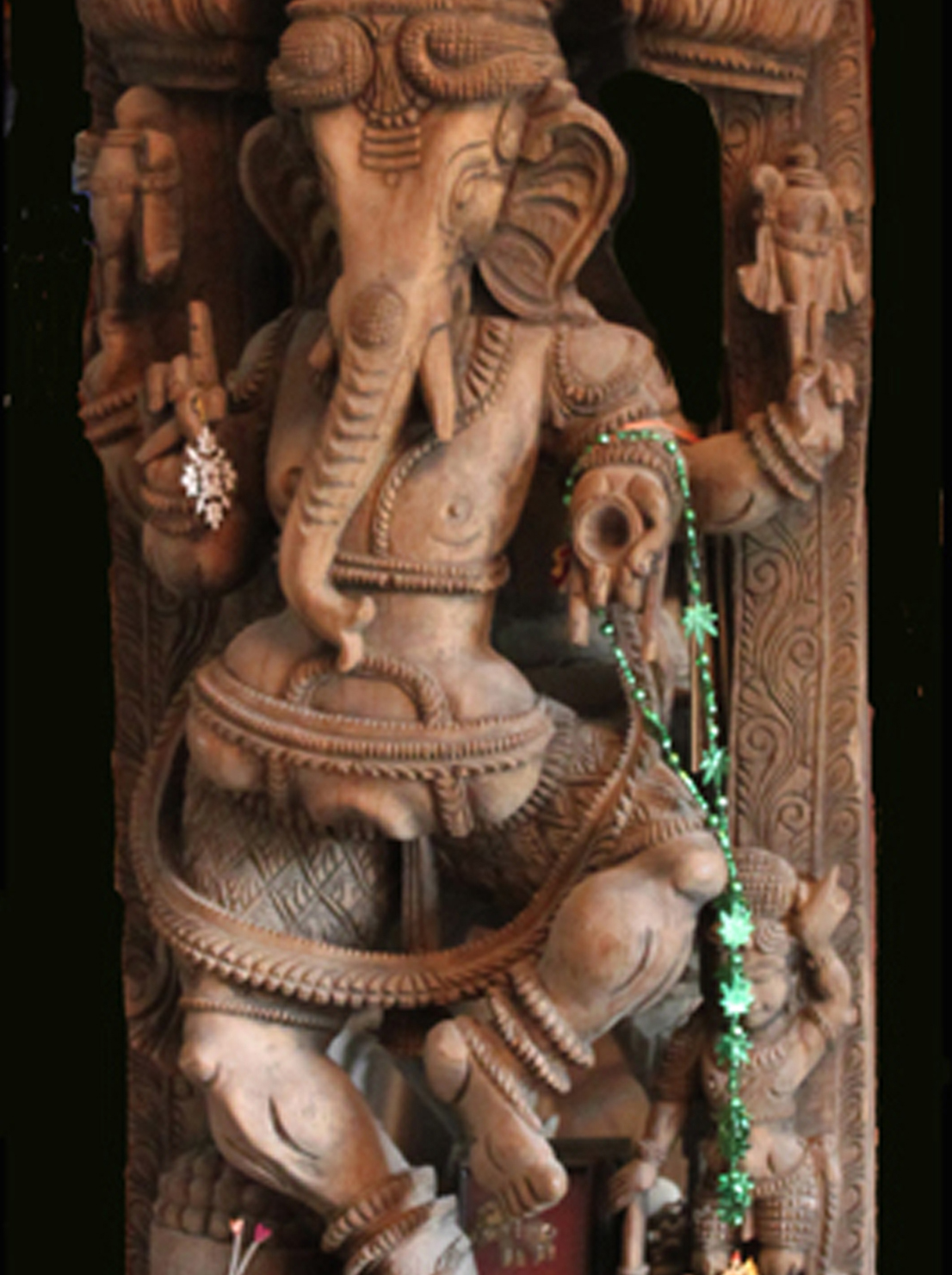
Ganesh
OK, the Ganesh. Here's how the Ganesh appeared in my life.
In Nepal, we had explored the ancient temples, Buddhist and Hindu, and we developed a fondness for the Hindu deity, Ganesh. There are three classic stories that I knew about him. The first one is about who he is and how he ended up with an elephant's head. Ganesh was the son of the supreme being, Shiva, and his equal feminine counterpart and consort, Parvati. She was known to have enjoyed luxuriating in her private bath, and when she did she would have Ganesh guard the entrance to the garden. One day, along came Shiva, after a long enough absence for Ganesh to have been born and grown to adulthood. Intending to enter the garden, he encountered Ganesh standing in his way. Shiva, not knowing that this was their son, cut off Ganesh's head and went on into the bath. Parvati was very glad to see Shiva, but then she asked, "Did you see our son Ganesh outside?"
Oops. Shiva had to get a new head for Ganesh, pronto, to bring him back to life, and so he went to various animals asking them to contribute a head. All refused until Shiva came to the elephant. In his wisdom, the elephant could see the larger picture and agreed. So in two ways in that story, Ganesh is associated with selfless devotion to duty: in guarding his mother's bath at the risk of his life; and in the elephant's willingness to give up his life as well, in order to play a part in a greater cosmic dance.

You don't have much contact with the Hindu culture growing up in a little Southern California beach town like Carpinteria, but I did get degrees in Political Science and Religious Studies at UCSB, and I did have some feel for Hinduism, the precursor to Buddhism. The Buddha was born a Hindu, like Jesus was born a Jew. The idea of a deity with an elephant head and a cosmology going back not 6000 years, but kalpas of time, a kalpa being several googolplexes of eons; was pretty far out to a Carpinteria boy. But then a billion people think the stories are perfectly valid, being as old as the hills, at least, and the way their parents told it to them, and their parents before them, and all the way back. They regard these narratives as being core to understanding the human experience. In the Hindu cosmology we are all recycled beings emerging into and disappearing from the present day, in different forms as we have always done. "We", being the one who is incarnated as every sentient being that ever existed. At least that's the way I understand it. I wanted to have a Ganesh to remind me of this trip.
But I have a problem when I go shopping. When there are too many choices, I get my circuits overloaded really easily. I thrive and excel when there are few choices and I can invent a new one; but too many choices, like choosing a color of paint from the infinite palate of your 21st century paint store, will render me without the power of decision. I thought I should work on that, my disability in the area of shopping.
As the days of our month and a half in Nepal passed and the day of our departure got near, I was trying again and again to succeed at shopping, but since there were thousands of choices, choosing was impossible. So on the last day in Kathmandu, Lokendra bought me that seated Ganesh, with four arms, the one I gave to my mom. So that's not the Ganesh I'm talking about here. That one has meaning for me because Lokendra bought it for me, and that my mom valued it because her son brought it to her from the far end of the planet. I still hadn't found the Ganesh I was looking for. I knew I would have more chances where we were going next.
Next we flew to Bangkok, spent a day or two seeing the sights and flew on to Bali. Bali is a small island in chain of large and small islands that make up the mostly Islamic country of Indonesia. It is predominantly Hindu. Balinese Hinduism is a blend of Hindu, Buddhist and local Animism; with spectacular expressions in the arts: stone carving, woodcarving, vivid paintings and batik cloth; and dazzling performances of ancient stories.
Another story about Ganesh is that was keeping company with the sage Vyasa when he was inspired to dictate the epic poem, the Mahabharata, and wished to have Ganesh to write it down while he recited it. Ganesh agreed on the condition and he must recite it without stopping. Vyasa agrees on the condition that Ganesh understand what has been said, before he writes it down. That way if Vyasa wants to slow down the process and give himself a break, the poet can make the story extra complicated or baffling. It is the longest poem ever written, literally, and in the midst of this divine transcription, Ganesh's pen breaks and, so as not to miss any of the epic, he breaks off his own tusk to use as a pen to finish the writing. It's another devotion to duty story, and you'll always see Ganesh holding his broken tusk in one of his hands and an inkwell in another. Often seen with four hands, never two.
We met up with other friends from California in Bali, stayed with an ex-pat surfer there and drove all around the island, and swam and snorkeled, and climbed up the fuming volcano and swam in the hot springs water piped to the hotel's pool by the lake in the crater. The people were really cool, very gentle and friendly, and enthusiastically Hindu. Everywhere throughout the island people were really involved with their neighborhood temples. There were lots of festivals and you would see the people streaming into the temples all dressed up with baskets of fruit and food on their heads.
Neighborhood temples put on elaborate action-filled operas of the stories from the Mahabharata and the Ramayana, with lots of dancing and chanting, drumming and Gamelan music. We had rooms at a small hotel in the center of Ubud, and all the people that worked there were part of the neighborhood temple When the time came, they were all gone from the hotel and soon we were down at the temple watching them in the costumes of Hindu deities, kings, warriors and monkey soldiers, acting out those very stories told by Vyasa to Ganesh. So Ganesh is very much a theme in their art and their stone carvings. So I thought that here, I would find Ganesh.
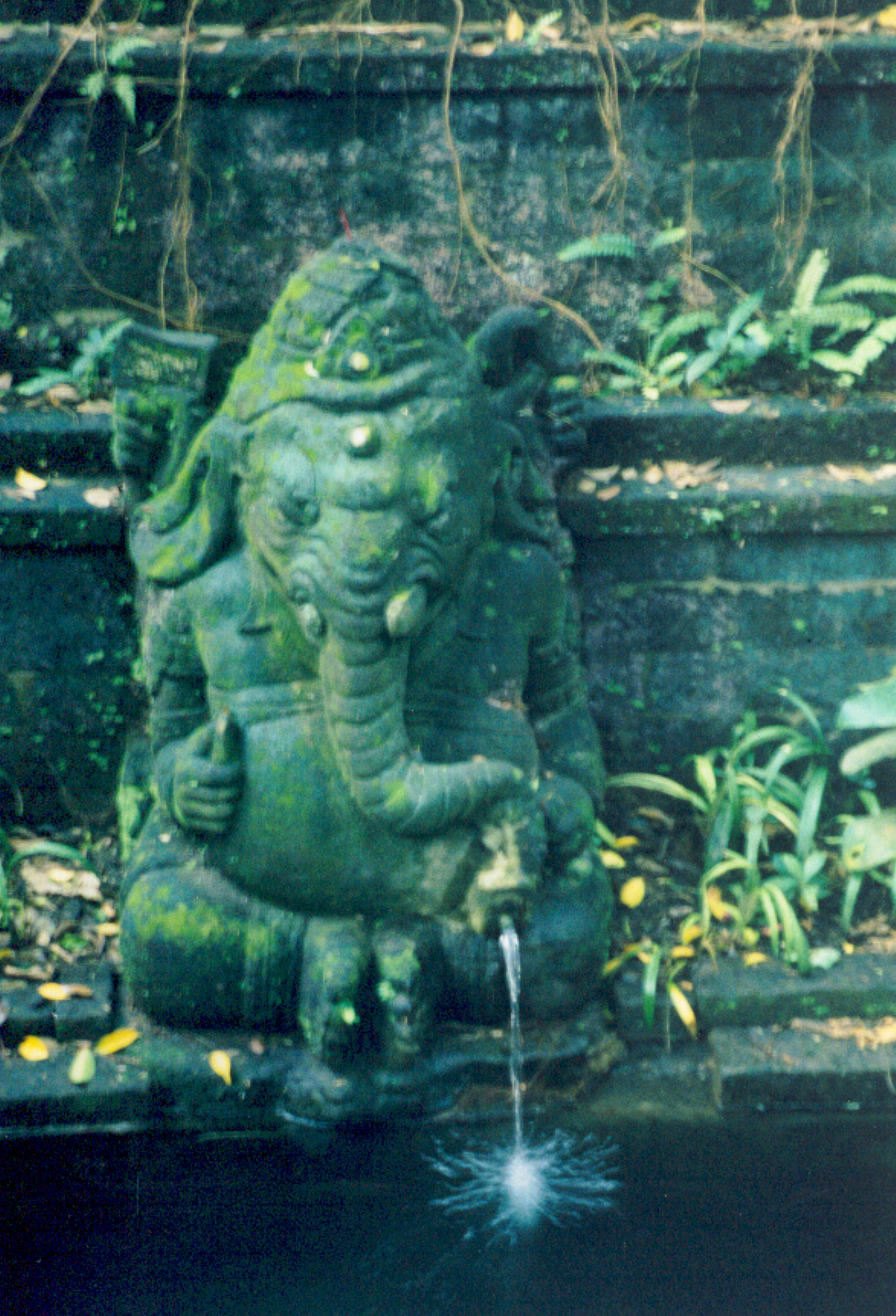
Well, I did. In the heart of Ubud is the Monkey Forest Temple. You descend carved stone Dragon Stairway into a lush gorge. Seated by a rectangular pond near the bottom of the stairway is a wonderful Ganesh with the spring's water gushing from his trunk onto his right hand, then into the pond, and the pond's overflow then continuing on down the gorge.
Two full sized monitor lizards, carved out of the natural stone walls, follow its flow over a waterfall.
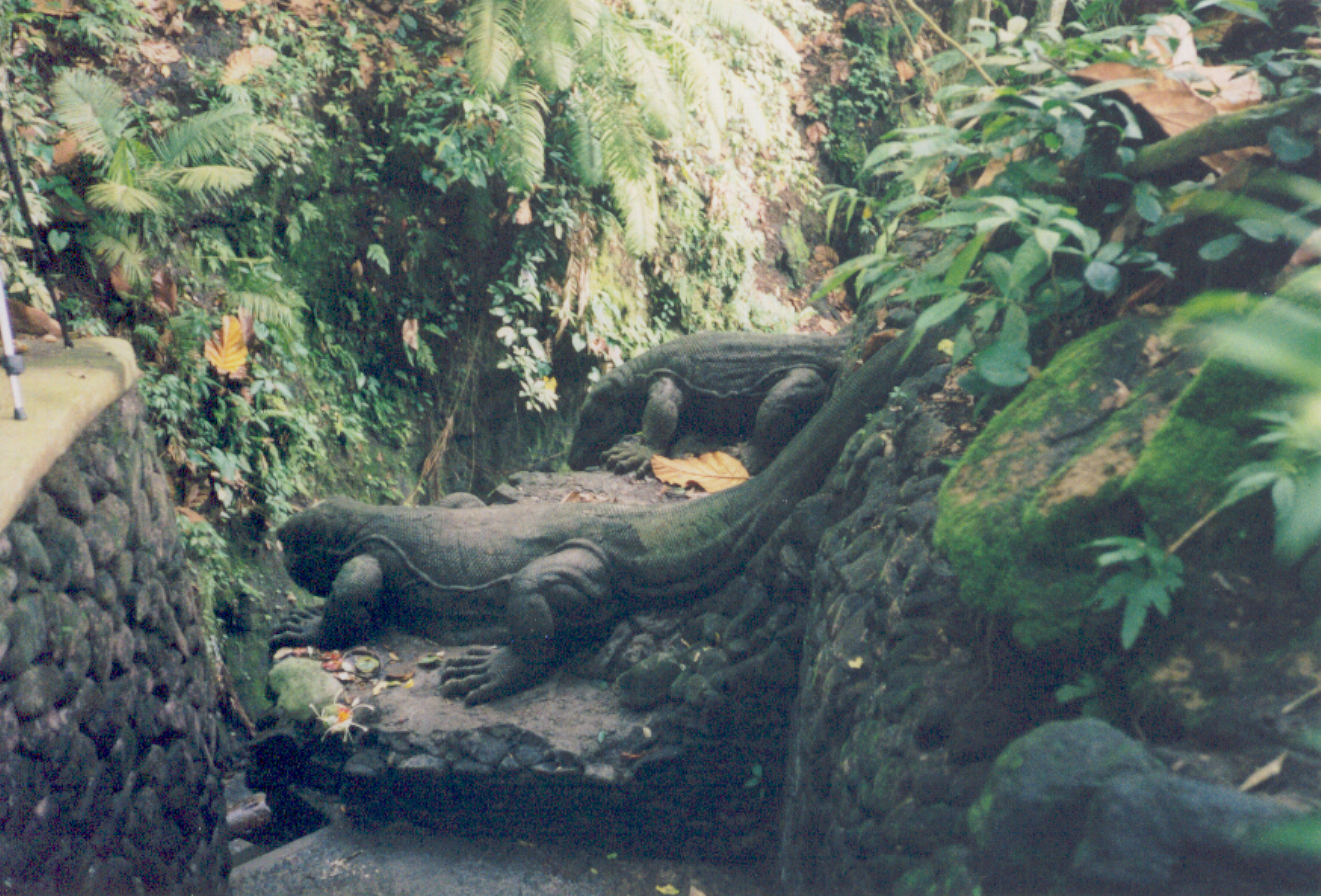
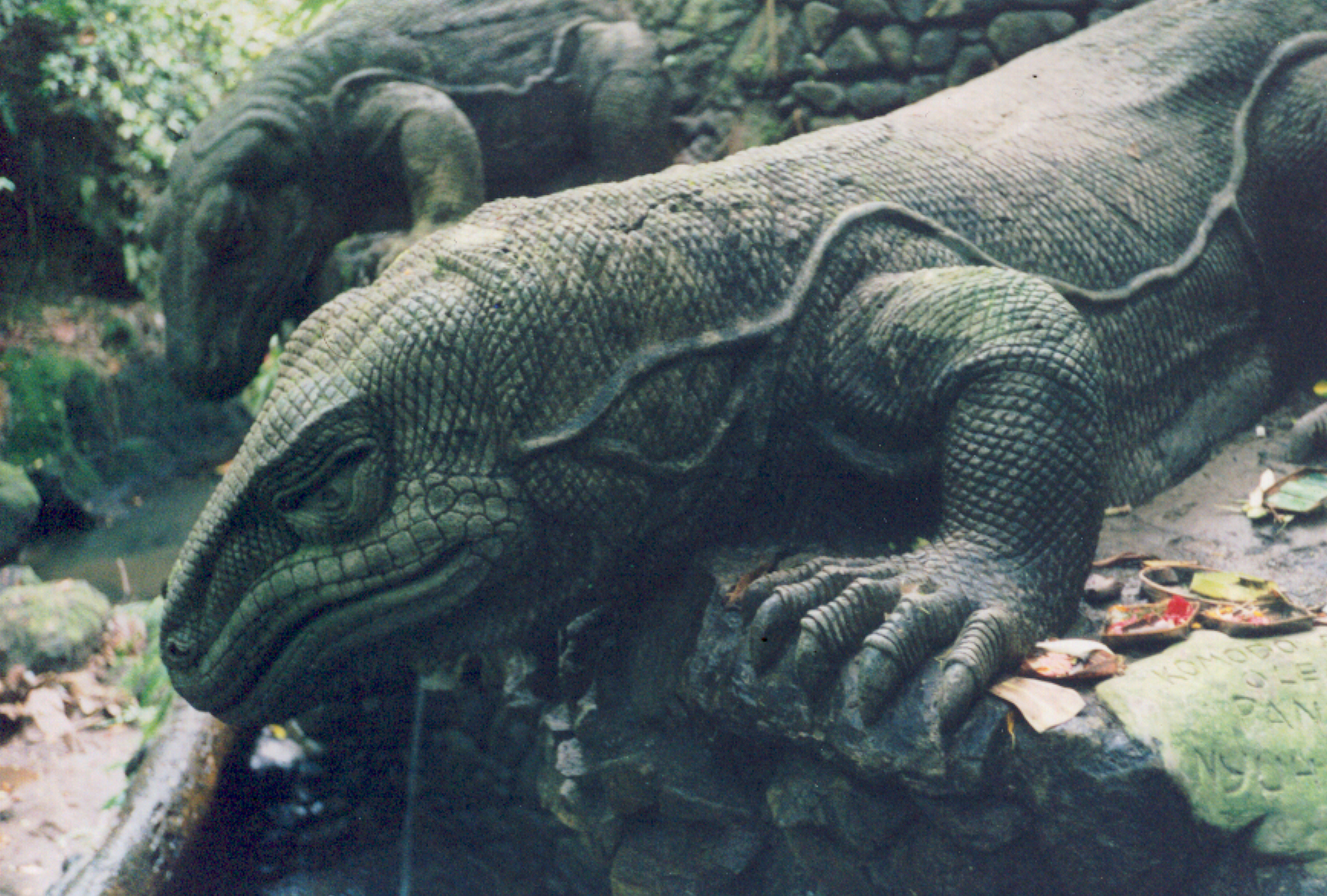
The third tale that I know about Ganesh is that he was a symbol of abundance and prosperity. And he was a party animal. The story is that Ganesh had been partying and feasting so much that his stomach burst open. He took a snake and lashed his gut back together with it so he could continue in his revelry. Images of Ganesh show him with a large stomach with a snake wrapped around.
You'd think I'd be able to find a Ganesh in Bali, if anywhere on the planet: Nope. The only thing I brought back from Bali was the strand of puka shells I found on the beach.
Back in California a few months later, perturbed at myself for my inability to shop, I set myself a task; I decided that I would go to the weekend sales, in the countryside surrounding Petaluma in search of old woodworking tools. I was successful almost every week, finding old wooden hand planes, draw knives and chisels. I began to get a sense of which yard sales and barn sales would be most likely to have what I was looking for; and I realized that you had to be on your toes and be at the right place first thing Saturday morning. So I would get up early, get the newspaper and note the addresses and descriptions under the garage sale heading to make a plan about where to go first.
Saturday March 13,1999, I was up early and I'd made my calculation where to go. In the "moving sale" ad, it listed tools in the description and an address on Ely Road. The Ely Road that I knew was in Penngrove, just to the north of Petaluma, more rural farm town. Great: In my mind's eye I imagined a farm being sold, an old barn where a younger generation would be selling off grandpa's old tools. Perfect. I timed it so I'd get there just before the opening bell.
I got to Penngrove about 7:45 and turned onto Ely Road. Open fields, barns corrals, farmhouses, I started looking for the address. Yikes: From the looks of the address, the sale was many, many blocks away. And as I drove on, after a couple miles, I was entering the northern edge of Petaluma's newer suburban development, and it became clear that there was not going to be old barn, in fact, at one point, before I had reached the house number, Ely Road Came to an end!
Then I pulled out the map. There was Ely Road North, then for a mile it was called Sonoma Mountain Parkway, after that it became Ely Road South. I drove on, by then it was after 8:00am, and I was passing through the shopping centers and into an area of older suburbs and I realized that the house number was going to be in a townhouse. This was anything but the scenario I had envisioned. I easily found the sale. There was an open garage with an avalanche of outgrown children's toys and strollers, cribs, playpens and clothing spilling down the driveway.
I decided I would go look at the tools mentioned in the ad anyway. The tools were cheap householders' tools: an electric drill, some screwdrivers and wrenches. I wandered, kind of dispirited, into the back of the garage. There it was: the most beautiful wood carved Ganesh I had ever seen. It was in the very back corner of the garage, with other stuff leaning up against it. It had a piece of paper taped to it the said: $200. I quickly found the fellow that was running the sale.
"Would you take $100 for the Ganesh?" I said, trying to contain my excitement.
He said, "The what?" "That wood carving back there in the corner of the garage, It says $200 on it."
He said, "Oh, that thing. You know, my dad brought that back from one of his travels. I think he said he paid $800 for it. How about $125?"
Of course. I would have paid the $200, I even thought that that price must have been some kind of mistake. Walking to the truck with the Ganesh, I felt that I was getting away something, like someone was going shout at me, "Hey you, wait a minute, where are you going with that." But no, I was driving away with it, my heart pounding.
When I got home, I found Carol out back relaxing in her hot tub. I told her close her eyes; I had a surprise. She did, and I brought out the Ganesh. She had an even bigger reaction than I had; she gasped and gasped; I thought she was going to have a heart attack. Like Parvati, she was in her bath when she first laid eyes on the elephant-headed boy.
The carving is from a single piece of wood: about 4 feet tall and 16 inches wide. I never gotten an expert opinion, but I believe it's from India. It took me a long search to find one that looks anything like this one. This one is dancing and displays some of the classic iconography: the tusk is broken off and held in his lower right hand; in his lower left hand he holds the inkwell; he is dancing, with one foot off the ground; a snake is wrapped around his distended belly. The little finger, right hand was broken off and lost before I found this Ganesh. There must have been more to the canopy, but that's also broken off and lost.
I made a redwood altar for it with a mirror that gives definition to the carving on the back, and a heavy curly-grained redwood shelf to hold offerings. It's been mounted to the wall in a prominent place in our living room ever since.
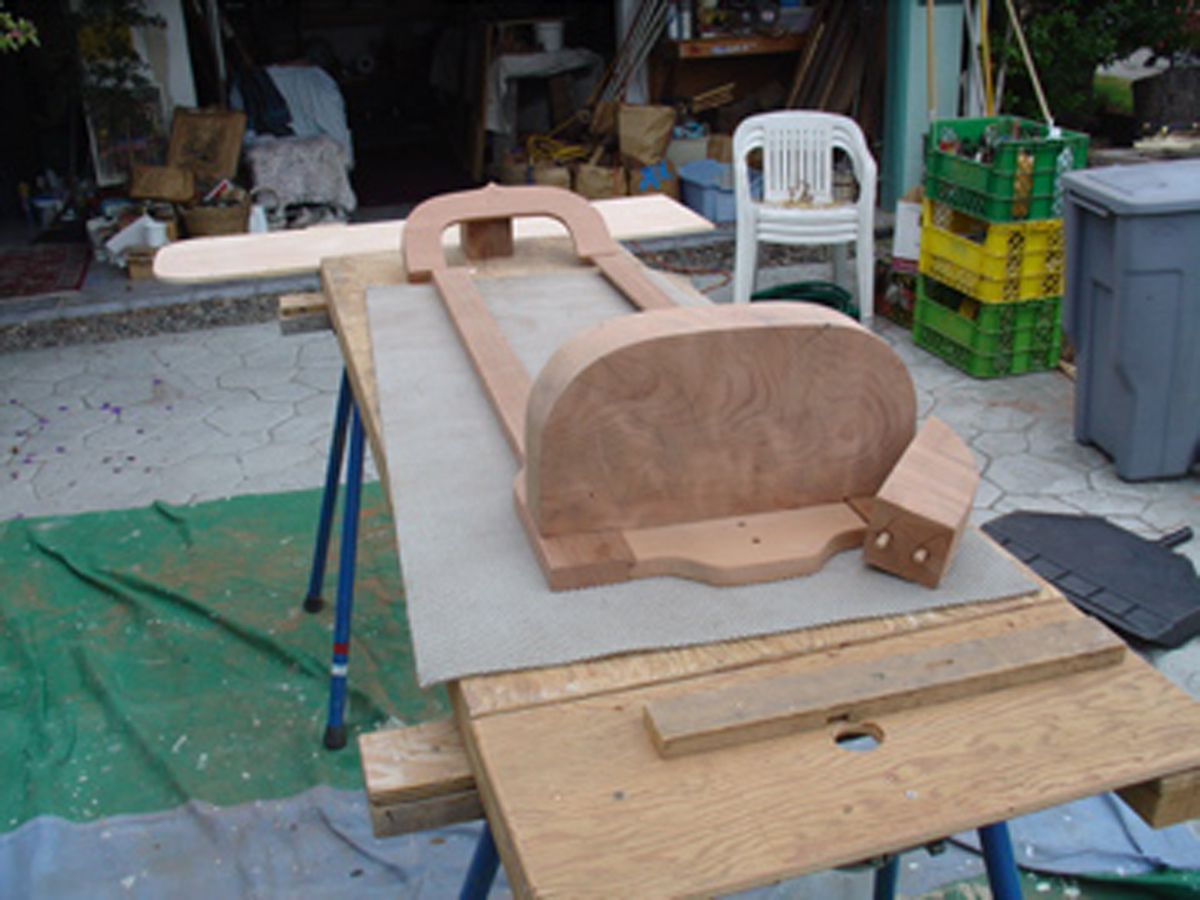

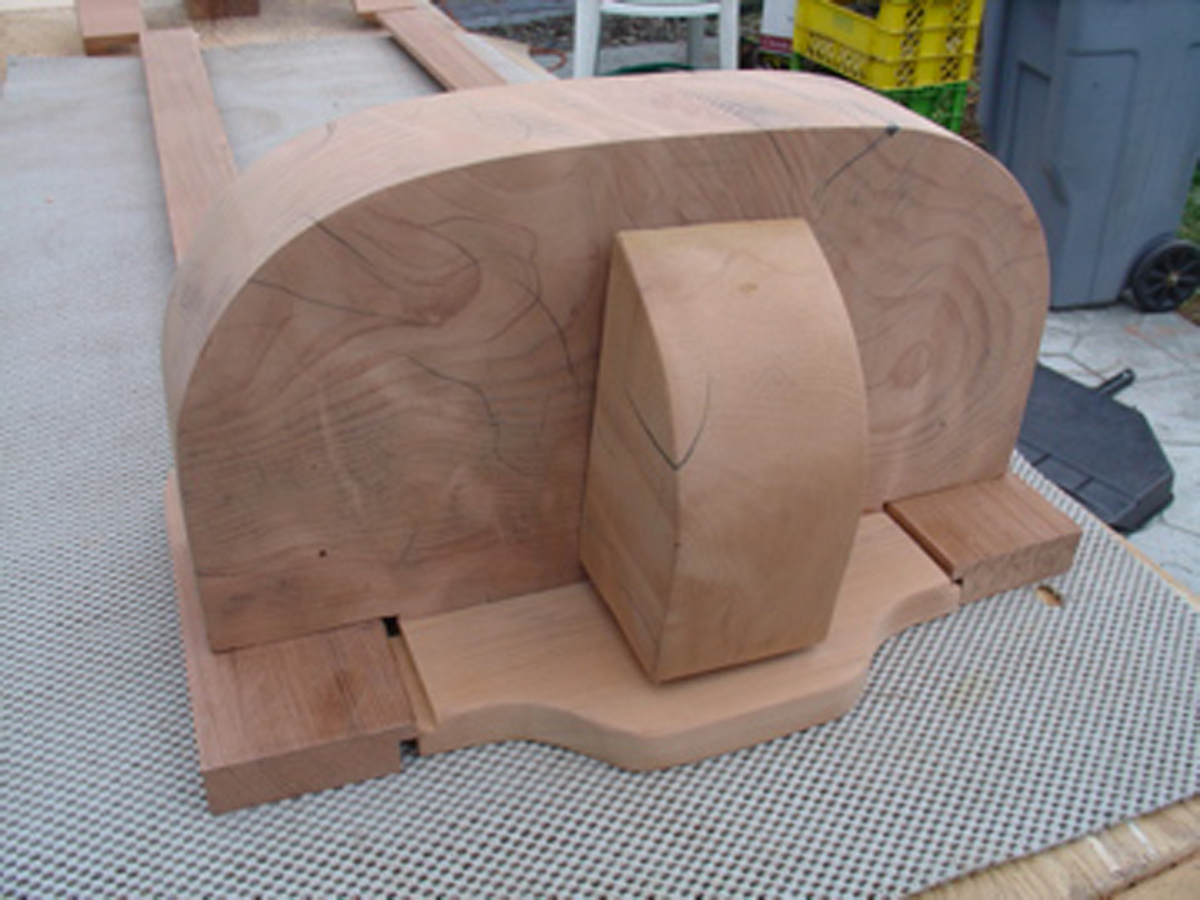



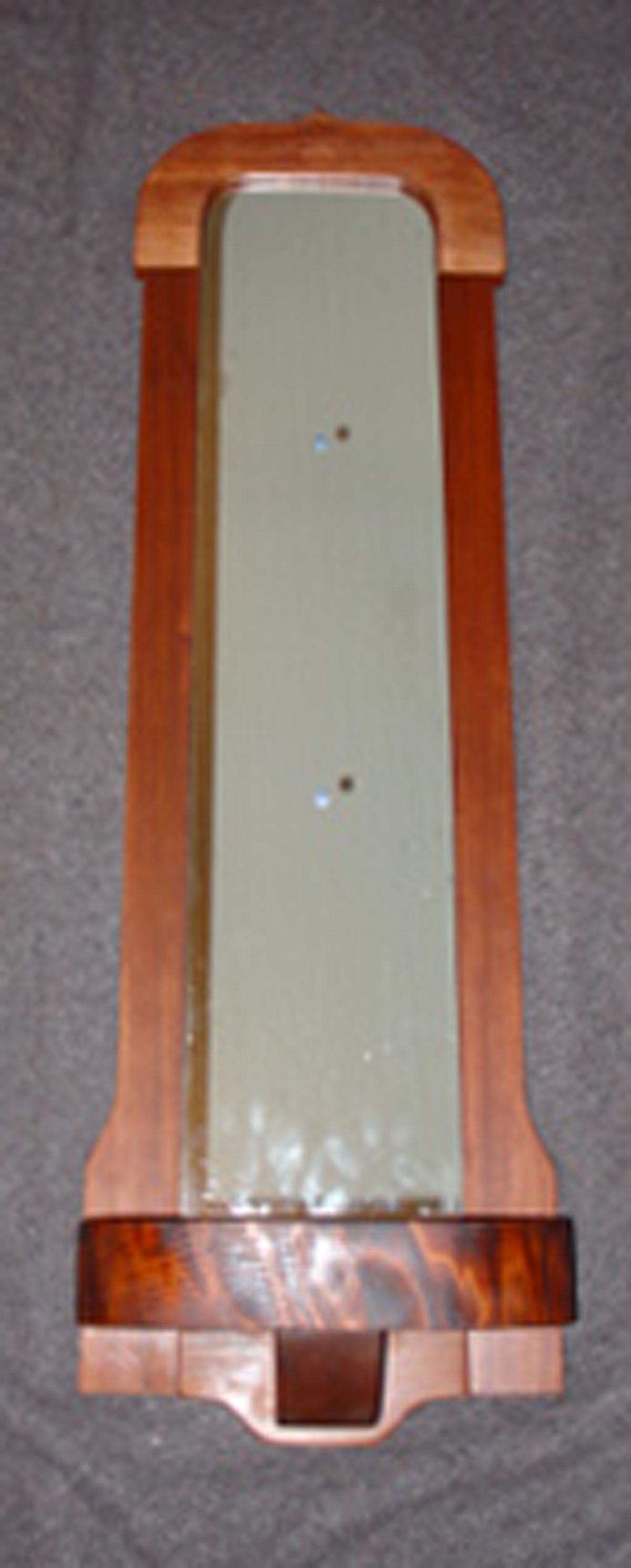
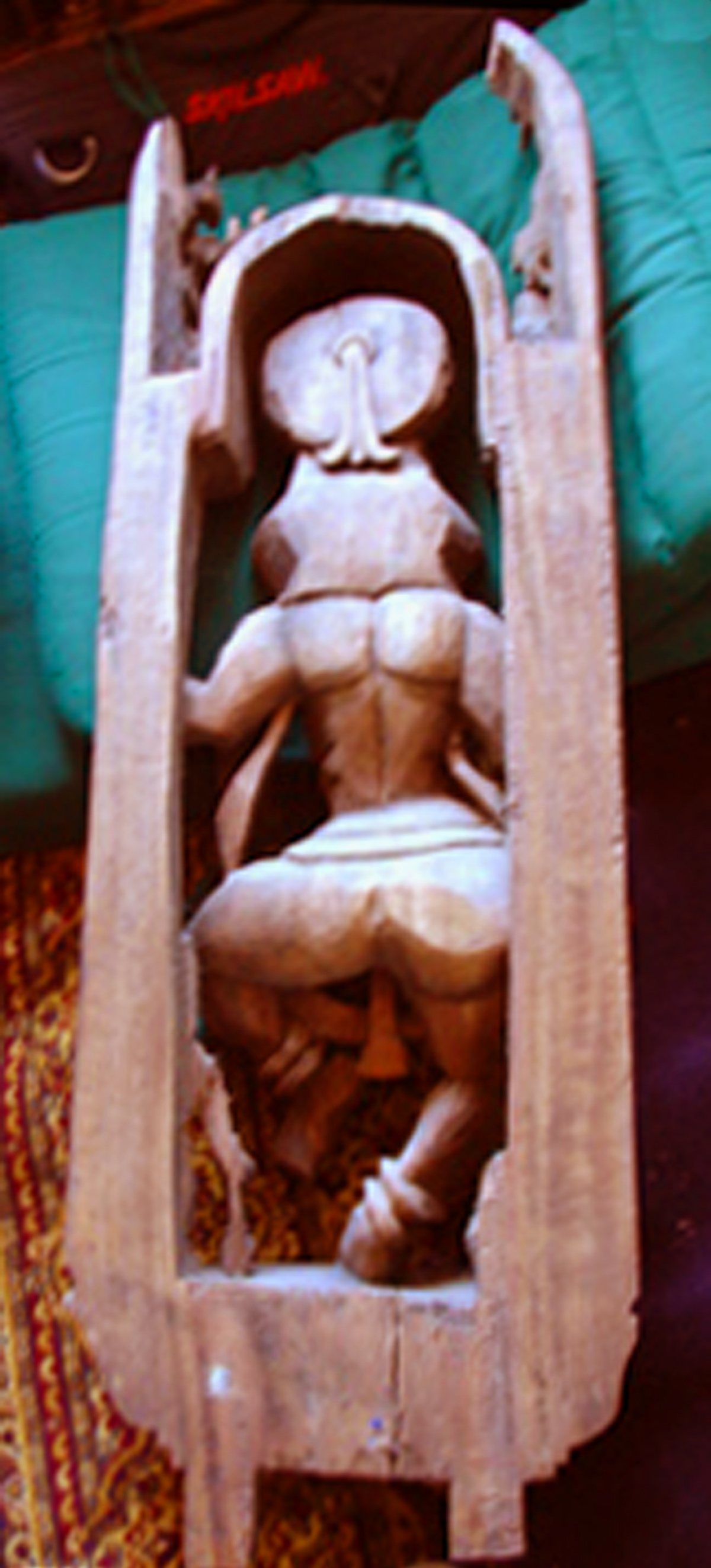
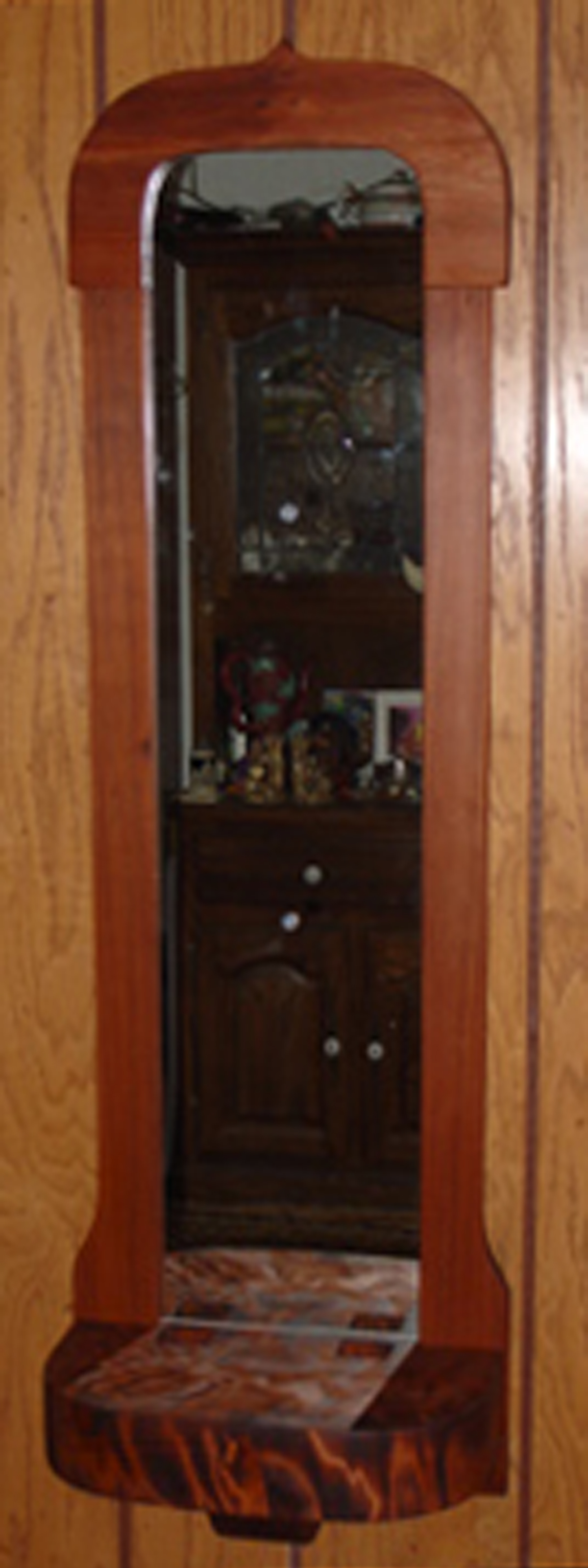
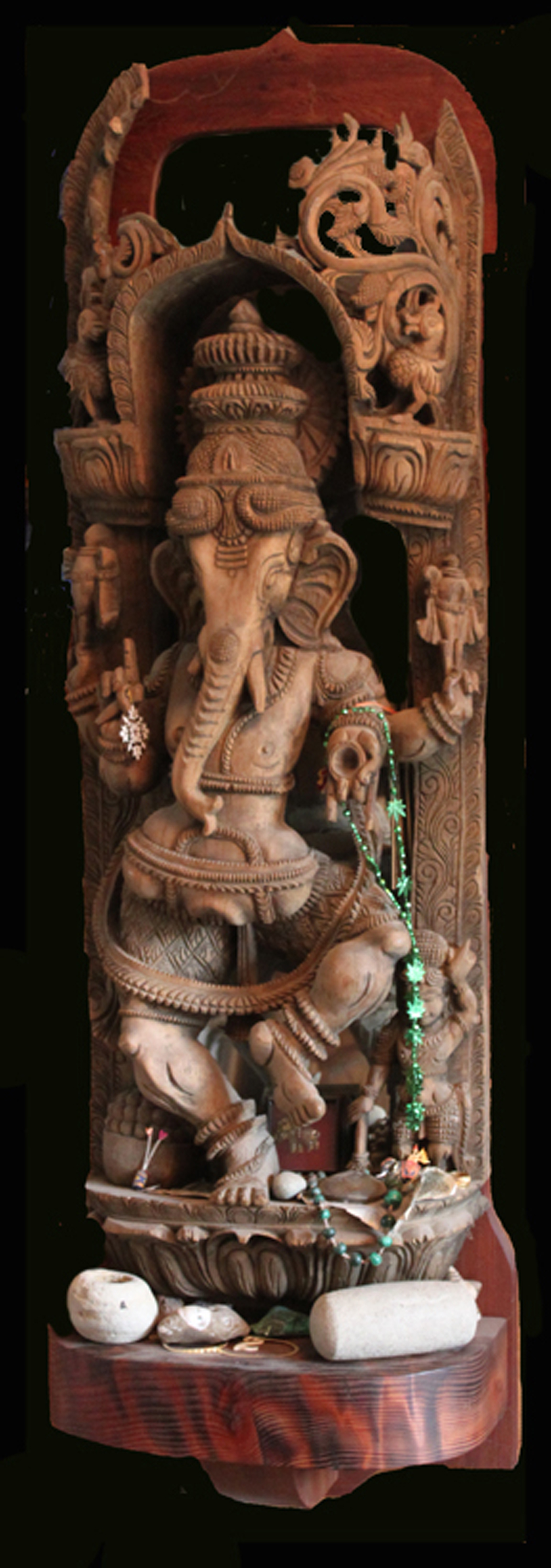
Disclaimer:
Not for sale. Uncle John's Garage Sale is just the name of the book.
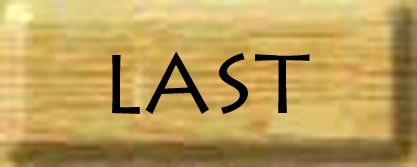

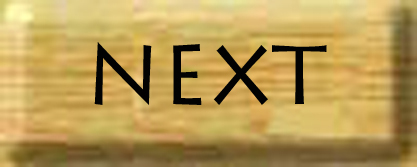
© 2022 John Oliver
All Rights Reserved
mail@unclejohnsweb.com

OK, the Ganesh. Here's how the Ganesh appeared in my life.
In Nepal, we had explored the ancient temples, Buddhist and Hindu, and we developed a fondness for the Hindu deity, Ganesh. There are three classic stories that I knew about him. The first one is about who he is and how he ended up with an elephant's head. Ganesh was the son of the supreme being, Shiva, and his equal feminine counterpart and consort, Parvati. She was known to have enjoyed luxuriating in her private bath, and when she did she would have Ganesh guard the entrance to the garden. One day, along came Shiva, after a long enough absence for Ganesh to have been born and grown to adulthood. Intending to enter the garden, he encountered Ganesh standing in his way. Shiva, not knowing that this was their son, cut off Ganesh's head and went on into the bath. Parvati was very glad to see Shiva, but then she asked, "Did you see our son Ganesh outside?"
Oops. Shiva had to get a new head for Ganesh, pronto, to bring him back to life, and so he went to various animals asking them to contribute a head. All refused until Shiva came to the elephant. In his wisdom, the elephant could see the larger picture and agreed. So in two ways in that story, Ganesh is associated with selfless devotion to duty: in guarding his mother's bath at the risk of his life; and in the elephant's willingness to give up his life as well, in order to play a part in a greater cosmic dance.

But I have a problem when I go shopping. When there are too many choices, I get my circuits overloaded really easily. I thrive and excel when there are few choices and I can invent a new one; but too many choices, like choosing a color of paint from the infinite palate of your 21st century paint store, will render me without the power of decision. I thought I should work on that, my disability in the area of shopping. As the days of our month and a half in Nepal passed and the day of our departure got near, I was trying again and again to succeed at shopping, but since there were thousands of choices, choosing was impossible. So on the last day in Kathmandu, Lokendra bought me that seated Ganesh, with four arms, the one I gave to my mom. So that's not the Ganesh I'm talking about here. That one has meaning for me because Lokendra bought it for me, and that my mom valued it because her son brought it to her from the far end of the planet. I still hadn't found the Ganesh I was looking for. I knew I would have more chances where we were going next.
Next we flew to Bangkok, spent a day or two seeing the sights and flew on to Bali. Bali is a small island in chain of large and small islands that make up the mostly Islamic country of Indonesia. It is predominantly Hindu. Balinese Hinduism is a blend of Hindu, Buddhist and local Animism; with spectacular expressions in the arts: stone carving, woodcarving, vivid paintings and batik cloth; and dazzling performances of ancient stories.
Another story about Ganesh is that was keeping company with the sage Vyasa when he was inspired to dictate the epic poem, the Mahabharata, and wished to have Ganesh to write it down while he recited it. Ganesh agreed on the condition and he must recite it without stopping. Vyasa agrees on the condition that Ganesh understand what has been said, before he writes it down. That way if Vyasa wants to slow down the process and give himself a break, the poet can make the story extra complicated or baffling. It is the longest poem ever written, literally, and in the midst of this divine transcription, Ganesh's pen breaks and, so as not to miss any of the epic, he breaks off his own tusk to use as a pen to finish the writing. It's another devotion to duty story, and you'll always see Ganesh holding his broken tusk in one of his hands and an inkwell in another. Often seen with four hands, never two.
We met up with other friends from California in Bali, stayed with an ex-pat surfer there and drove all around the island, and swam and snorkeled, and climbed up the fuming volcano and swam in the hot springs water piped to the hotel's pool by the lake in the crater. The people were really cool, very gentle and friendly, and enthusiastically Hindu. Everywhere throughout the island people were really involved with their neighborhood temples. There were lots of festivals and you would see the people streaming into the temples all dressed up with baskets of fruit and food on their heads.
Neighborhood temples put on elaborate action-filled operas of the stories from the Mahabharata and the Ramayana, with lots of dancing and chanting, drumming and Gamelan music. We had rooms at a small hotel in the center of Ubud, and all the people that worked there were part of the neighborhood temple When the time came, they were all gone from the hotel and soon we were down at the temple watching them in the costumes of Hindu deities, kings, warriors and monkey soldiers, acting out those very stories told by Vyasa to Ganesh. So Ganesh is very much a theme in their art and their stone carvings. So I thought that here, I would find Ganesh.

Well, I did. In the heart of Ubud is the Monkey Forest Temple. You descend carved stone Dragon Stairway into a lush gorge. Seated by a rectangular pond near the bottom of the stairway is a wonderful Ganesh with the spring's water gushing from his trunk onto his right hand, then into the pond, and the pond's overflow then continuing on down the gorge. Two full sized monitor lizards, carved out of the natural stone walls, follow its flow over a waterfall.


The third tale that I know about Ganesh is that he was a symbol of abundance and prosperity. And he was a party animal. The story is that Ganesh had been partying and feasting so much that his stomach burst open. He took a snake and lashed his gut back together with it so he could continue in his revelry. Images of Ganesh show him with a large stomach with a snake wrapped around.
You'd think I'd be able to find a Ganesh in Bali, if anywhere on the planet: Nope. The only thing I brought back from Bali was the strand of puka shells I found on the beach.
Back in California a few months later, perturbed at myself for my inability to shop, I set myself a task; I decided that I would go to the weekend sales, in the countryside surrounding Petaluma in search of old woodworking tools. I was successful almost every week, finding old wooden hand planes, draw knives and chisels. I began to get a sense of which yard sales and barn sales would be most likely to have what I was looking for; and I realized that you had to be on your toes and be at the right place first thing Saturday morning. So I would get up early, get the newspaper and note the addresses and descriptions under the garage sale heading to make a plan about where to go first.
Saturday March 13,1999, I was up early and I'd made my calculation where to go. In the "moving sale" ad, it listed tools in the description and an address on Ely Road. The Ely Road that I knew was in Penngrove, just to the north of Petaluma, more rural farm town. Great: In my mind's eye I imagined a farm being sold, an old barn where a younger generation would be selling off grandpa's old tools. Perfect. I timed it so I'd get there just before the opening bell. I got to Penngrove about 7:45 and turned onto Ely Road. Open fields, barns corrals, farmhouses, I started looking for the address. Yikes: From the looks of the address, the sale was many, many blocks away. And as I drove on, after a couple miles, I was entering the northern edge of Petaluma's newer suburban development, and it became clear that there was not going to be old barn, in fact, at one point, before I had reached the house number, Ely Road Came to an end!
Then I pulled out the map. There was Ely Road North, then for a mile it was called Sonoma Mountain Parkway, after that it became Ely Road South. I drove on, by then it was after 8:00am, and I was passing through the shopping centers and into an area of older suburbs and I realized that the house number was going to be in a townhouse. This was anything but the scenario I had envisioned. I easily found the sale. There was an open garage with an avalanche of outgrown children's toys and strollers, cribs, playpens and clothing spilling down the driveway.
I decided I would go look at the tools mentioned in the ad anyway. The tools were cheap householders' tools: an electric drill, some screwdrivers and wrenches. I wandered, kind of dispirited, into the back of the garage. There it was: the most beautiful wood carved Ganesh I had ever seen. It was in the very back corner of the garage, with other stuff leaning up against it. It had a piece of paper taped to it the said: $200. I quickly found the fellow that was running the sale.
"Would you take $100 for the Ganesh?" I said, trying to contain my excitement. He said, "The what?" "That wood carving back there in the corner of the garage, It says $200 on it." He said, "Oh, that thing. You know, my dad brought that back from one of his travels. I think he said he paid $800 for it. How about $125?" Of course. I would have paid the $200, I even thought that that price must have been some kind of mistake. Walking to the truck with the Ganesh, I felt that I was getting away something, like someone was going shout at me, "Hey you, wait a minute, where are you going with that." But no, I was driving away with it, my heart pounding.
When I got home, I found Carol out back relaxing in her hot tub. I told her close her eyes; I had a surprise. She did, and I brought out the Ganesh. She had an even bigger reaction than I had; she gasped and gasped; I thought she was going to have a heart attack. Like Parvati, she was in her bath when she first laid eyes on the elephant-headed boy.
The carving is from a single piece of wood: about 4 feet tall and 16 inches wide. I never gotten an expert opinion, but I believe it's from India. It took me a long search to find one that looks anything like this one. This one is dancing and displays some of the classic iconography: the tusk is broken off and held in his lower right hand; in his lower left hand he holds the inkwell; he is dancing, with one foot off the ground; a snake is wrapped around his distended belly. The little finger, right hand was broken off and lost before I found this Ganesh. There must have been more to the canopy, but that's also broken off and lost.
I made a redwood altar for it with a mirror that gives definition to the carving on the back, and a heavy curly-grained redwood shelf to hold offerings. It's been mounted to the wall in a prominent place in our living room ever since.










Not for sale. Uncle John's Garage Sale is just the name of the book.